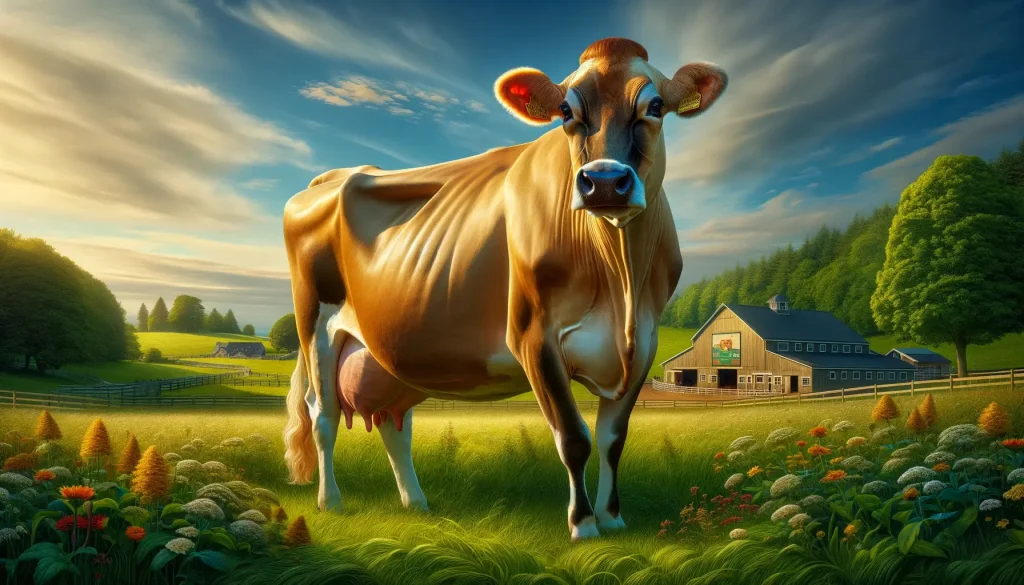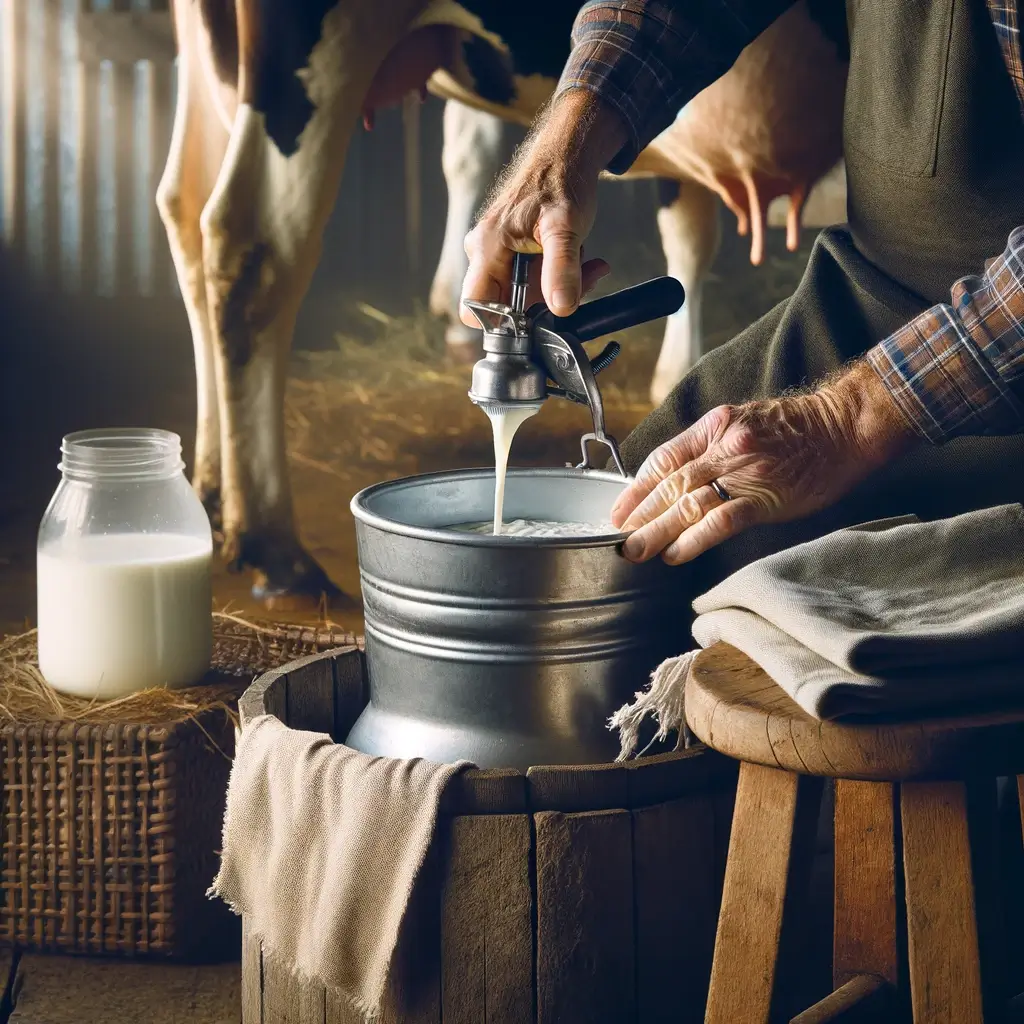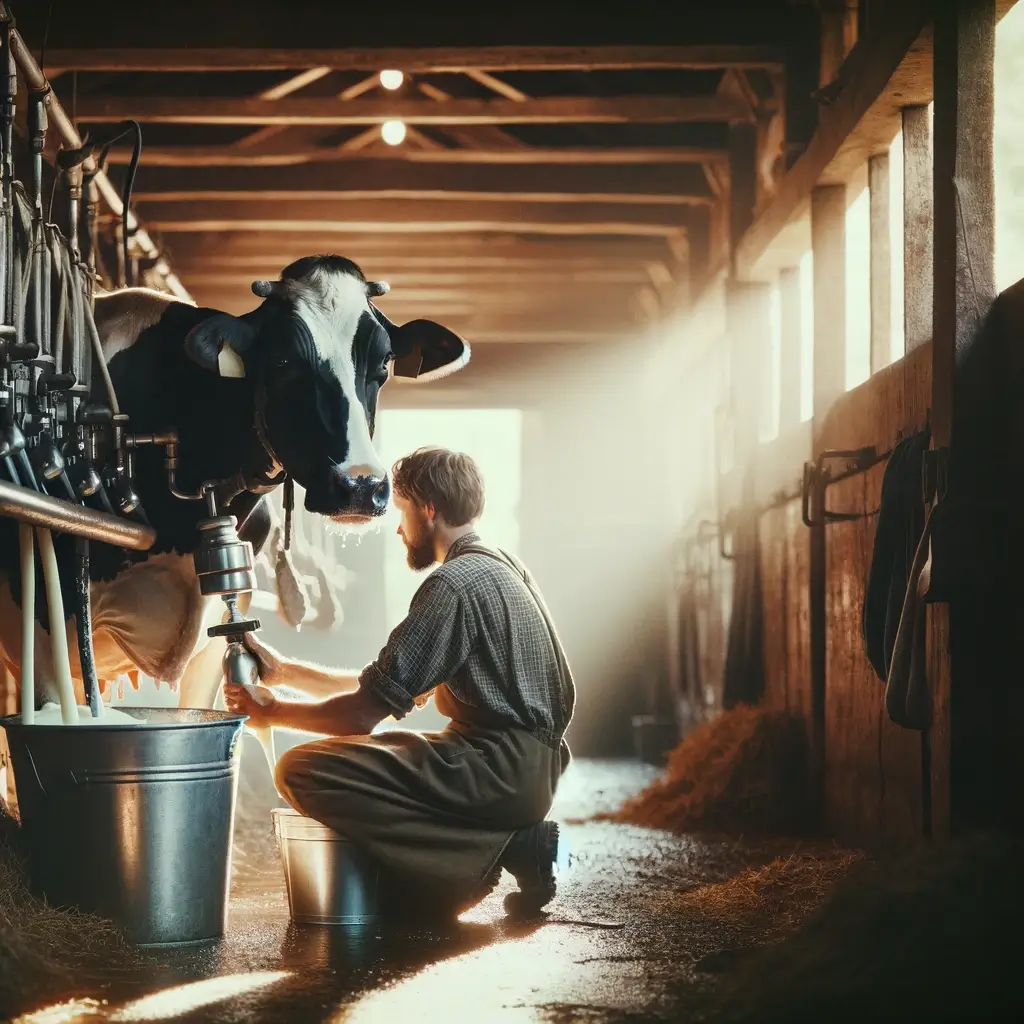
Owning a Family Milk Cow
Costs are a significant consideration. Purchasing a dairy cow ranges from $900-$3000, contingent on factors like age and proven milk production capabilities. Once you own a cow, the ongoing feeding cost primarily depends on hay prices and the availability of pasture, summing up to about 30-40 pounds of hay per cow, daily.
Choice of breed plays a part in your cow’s milk production and overall compatibility with your homesteading lifestyle. Popular breeds include Brown Swiss, Jerseys, Guernseys, and Dexters, each with unique traits and milk yields.
As for daily maintenance, having a family milk cow requires time for feeding, milking, and ensuring clean, accessible water. Expect to spend 15-30 minutes on milking alone, alongside other care practices.
Milk production varies, but generally, you can expect 3-4 gallons per day. This output depends on factors like breed, diet, and whether you’re engaging in practices like share-milking to balance lactation with your lifestyle needs.
Meeting your cow’s nutritional needs primarily involves a grass-based diet, with grazing during suitable seasons and hay (often a grass/alfalfa mix) during the colder months. Supplements and additional feed may be necessary depending on pasture quality and availability.
Exotic Pets FAQs
When it comes to choosing and caring for exotic pets, there are often many questions. Here are answers to some of the most frequently asked questions to help guide you.
Can exotic pets be house-trained?
Many exotic pets can be house-trained to a certain extent. It varies widely among species. For example, ferrets and certain reptiles can learn to use designated areas for waste.
Are exotic pets safe around children?
Safety depends on the type of pet and how well it’s supervised. Some exotic pets are not suitable for households with young children due to their specific care needs or defensive behaviors.
How much do exotic pets cost?
The cost can range from relatively inexpensive for some small rodents to several thousand dollars for larger, more rare species. Consider not just the initial cost but also housing, feeding, and veterinary care.
What do exotic pets eat?
Diet varies greatly by species. Some require fresh fruits and vegetables, while others need live food or specialized pellets. Research is key to providing a proper diet.
Do exotic pets need to see a vet?
Yes, like traditional pets, exotic animals require veterinary care. Finding a vet experienced with your pet’s species is crucial for their health and wellbeing.
How long do exotic pets live?
Lifespan varies widely. Some fish or small rodents live for a few years, while parrots and tortoises can live for decades. Consider the long-term commitment before acquiring an exotic pet.
Can I take my exotic pet outside?
Some exotic pets enjoy and even require some time outside, but it’s essential to do so safely and consider the pet’s environmental needs and escape risks.
Are exotic pets legal in my area?
Laws vary widely by location and species. It’s important to research local regulations and obtain any necessary permits before acquiring an exotic pet.
How much space do exotic pets need?
Space requirements depend on the species. While some birds and reptiles require large enclosures to roam, others have minimal space needs. Always provide the most generous amount of space possible.
What are common challenges with exotic pets?
Common challenges include finding veterinary care, meeting dietary needs, and providing an appropriate environment. Behavioral issues can also arise if the pet’s complex social and psychological needs are not met.

Cow vs. Goat for Your Homestead
When deciding between a cow and a goat for milk production on your homestead, consider your space. Cows generally need 2-5 acres each to graze comfortably. This space requirement might tip the scales if your homestead is on the smaller side. Each animal brings its own set of benefits to the table, but when it comes to raw milk quantity and the traditional dairy experience, cows lead the way, albeit requiring more land and care.
Feeding your milk cow is another aspect to ponder. A grass-based diet is ideal, including grazing in warmer months and hay in the colder part of the year. Expect to provide about 30-40 pounds of hay daily. Hay costs vary, so your location will impact feeding expenses.
What about the type of cow to get? The choice is yours, with popular family milk cow breeds including Brown Swiss, Jerseys, Guernseys, and Dexters. Each breed has its unique advantages, influencing milk production, temperament, and overall compatibility with your family and homestead lifestyle.
Owning a milk cow doesn’t necessarily mean you’re tied down to your homestead. Techniques like share-milking provide flexibility, allowing you to milk once a day while the calf feeds directly for part of the day. This can offer a balance between home dairying and the freedom to step away when needed.
Milk production varies, averaging 3-4 gallons per day, influenced by breed choice and diet. This yield supports not just drinking milk, but also homemade cheese, yogurt, and butter, extending the benefits of owning a milk cow beyond the milk itself.
Milking a cow is a skill, but it’s one you can learn. Keeping the milk clean involves simple practices like brushing off the cow and wiping the udder before milking. The choice to pasteurize is up to you, with many choosing to enjoy the benefits of fresh, raw milk directly from their cow.
The legal landscape around selling raw milk varies. Some areas allow it; others don’t or have specific regulations. Check your local laws if considering selling your cow’s milk.

Milk Cow Magic Fun Facts
Diving into the world of family milk cows reveals some fascinating tidbits. Here are fun facts that highlight the intrigue of these domestic giants.
- Cows have an acute sense of smell. They can detect odors up to six miles away, making their sense of smell stronger than dogs.
- Milk composition changes with the cow’s diet. For instance, grass-fed cows produce milk with higher levels of beneficial fatty acids and antioxidants.
- Cows are social animals. They form close friendships within their herds, and when separated from their companions, they experience stress and loneliness.
- The first cow to fly in an airplane was Elm Farm Ollie in 1930. Not only did she fly; she also was milked during the flight, producing 24 quarts of milk!
- A cow’s daily water intake is substantial. They drink about a bathtub’s worth of water each day, around 30-50 gallons, especially when lactating.
- Cows have nearly 360-degree panoramic vision. This wide field of vision helps them see predators from all angles, but they have difficulty focusing on objects right in front of them.
- The world record for milk production. A Holstein cow named Smurf has produced over 57,000 gallons of milk in her lifetime—more than double the average cow.
These facts about family milk cows add an extra layer of appreciation for these animals beyond their role in home dairying. They are remarkable creatures with unique abilities and traits that captivate and contribute to our homesteads in more ways than one.
Costs and Responsibilities of Owning a Family Milk Cow
Owning a family milk cow comes with its set of costs and responsibilities that potential owners should be aware of. Understanding these aspects helps in making an informed decision, ensuring a rewarding experience for both the family and the cow.
Initial and Ongoing Costs
The initial cost of purchasing a dairy cow varies, generally falling between $900 and $3000. This price range can change based on the breed, age, and milk production history of the cow. Once you bring your milk cow home, the expenses don’t stop there. Feeding your cow properly is essential, with a daily requirement of roughly 30-40 pounds of hay. The cost of hay and the availability of pasture land play significant roles in the overall feeding expenses.
Recommended Diet for Optimal Health and Milk Production
A grass-based diet is crucial for your cow’s health and the quality of milk produced. During the warmer months, cows thrive on pasture grazing, while in colder seasons, a diet of high-quality hay, preferably a grass/alfalfa mix, is recommended. The diet may need to be supplemented depending on the quality and availability of pasture.
Breeding for Milk Production
In order to produce milk, a cow must first have a calf. This means you will need to plan for breeding. Some homesteaders prefer to breed their cows annually, while others might opt for longer lactation cycles without yearly breeding. Deciding on this schedule depends on your milk requirements, the cow’s health, and your capacity to manage calving and milking schedules.
Choosing the Right Breed
The choice of breed greatly influences milk production, temperament, and overall compatibility with your homesteading lifestyle. Breeds like Brown Swiss, Jerseys, Guernseys, and Dexters are popular for family milk cows, each with its unique characteristics. Considerations include milk yield, butterfat content, and the cow’s adaptability to your local environment.
Companionship for Your Cow
While cows are herd animals and prefer the company of their kind, they can adapt to being the only cow on a homestead if they have companionship from other animals such as goats or horses. Ensuring that your cow doesn’t feel isolated is crucial for its emotional and physical wellbeing.
Understanding these aspects of owning a family milk cow prepares aspiring homesteaders for the journey ahead. The commitment to providing proper care, adequate space, and companionship will result in a fulfilling relationship between your family and your milk cow, along with the rich rewards of home dairying.


Easy Steps for Milking Your Cow
Milking a cow is a hands-on task that requires patience and practice. Here’s how to get started:
Prepare your cow and the area. Make sure the cow’s udder and surrounding area are clean. Use a simple brush to remove any debris or dirt. A clean environment is crucial for quality milk.
Get comfortable. Whether you’re using a stool or a bucket to sit on, position yourself beside the cow comfortably. A relaxed cow and milker make the process easier.
Wash your hands and the udder. Before you start, wash your hands thoroughly. Then, using a clean cloth and warm water, gently wash the cow’s udder and teats. This not only cleans the area but also stimulates the cow, signaling that it’s time to release milk.
Begin milking. Gently but firmly grasp a teat near its base, and squeeze downward, allowing the milk to flow into your container. Work systematically, emptying each teat, one at a time. Avoid pulling or tugging harshly.
Finish with care. Once you’ve finished milking, offer your cow a pat of thanks. Apply teat dip to help prevent any infections. This ensures your cow remains healthy and ready for the next milking session.
Strain and cool the milk quickly. Use a fine mesh strainer to remove any impurities from the milk as soon as you finish milking. Then, cool the milk as quickly as possible to maintain its freshness and quality.
Practice makes perfect. Milking is a skill that improves with time. Consistency and patience are key.
Beginner Guide to Raising Quail at Home
What are the Signs of a Dog Concussion?
What Causes Your Dog’s Ears to Smell Bad?
When your dog’s ears start to emit an unpleasant odor, it might leave you puzzled…
Methimazole Treatment for Cat Hyperthyroidism
Methimazole plays a crucial role in managing feline hyperthyroidism, a condition marked by an overactive…
Got Hummingbirds in your Backyard? Here’s How to Care for Them.
Why Does Your Cat Pee Outside the Litter Box?
Cat’s Litter Box Issues It’s not uncommon for cat owners to face the frustrating dilemma…




